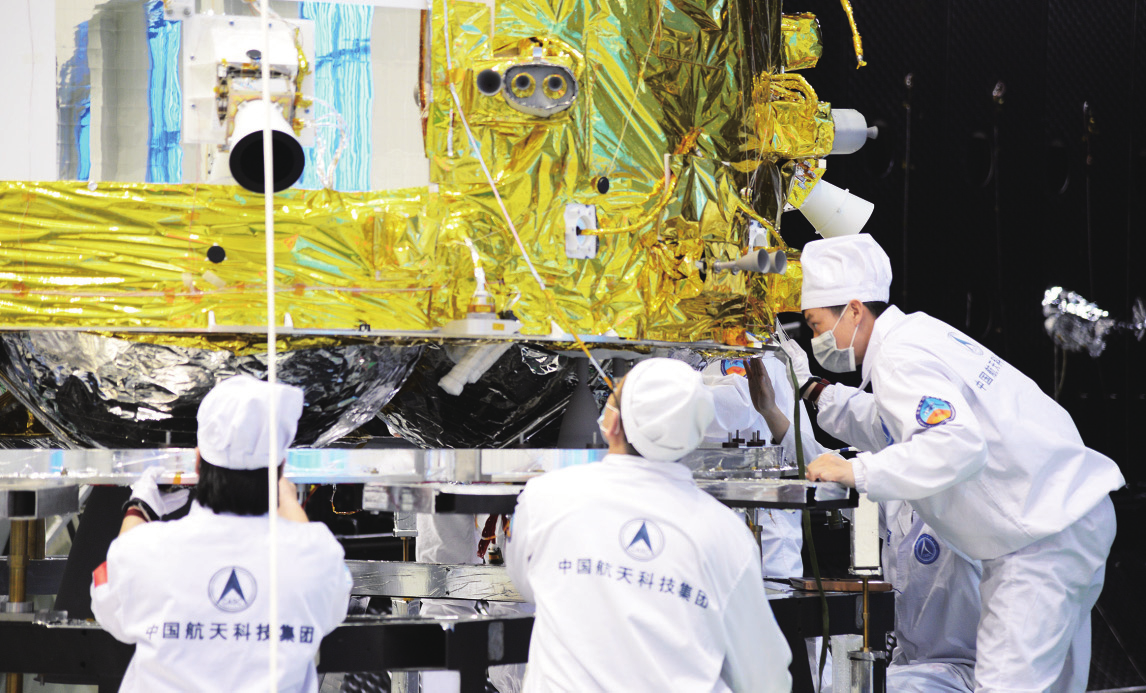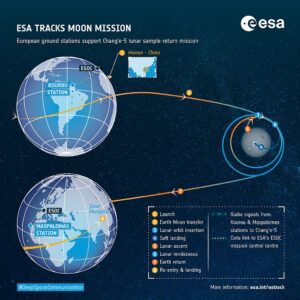
While it was an exciting week last week in space news with the launch of American and Japanese astronauts on a SpaceX rocket followed by the launch of the European/American Sentinel-6 Earth Observing satellite, China is about to embark on an even more impressive mission. Today they launched a spacecraft to the moon that’ll retrieve samples from the lunar soil and return them to Earth. This will be the first time in more than 40 years such an endeavor was pursued; it also marks another leap in China’s plan to establish human moonbases there.
Known as the Chang’E-5 Mission, China launched its massive Long March 5 rocket into space from the Wenchange Satellite Launch Center on the island of Hainan in Sanya, China. The large launch vehicle is sending an orbiter, re-entry capsule, lander, and descender to space. The orbiter will allow the spacecraft to orbit around the Moon to a desired landing location. There, the descender would bring the lander to the surface of the Moon where a drill would be deployed to capture a coring sample. The lander would then use a claw to grab the sample and stow it. Once enough rock and soil was captured, the lunar lander would take-off from the surface of the Moon and re-dock with the orbiter. The orbiter would then return it to Earth, separating the unit from the orbiter as it re-enters the Earth’s atmosphere prior to a touchdown in China.
The lander will feature high-tech tools including cameras, a spectrometer to determine mineral composition, a soil gas analytical instrument, a soil composition analytical instrument, a sampling sectional thermo-detector, and ground-penetrating RADAR.

While there is no cooperation with the United States on this mission, the European Space Agency (ESA) is participating by providing tracking support to China. ESA is tracking the spacecraft during the launch and landing process while providing back-up to China’s ground stations.
The lander is due to return to Earth around December 16 or 17.
China hopes to bring back about 4.4 pounds of lunar soil and rock back to the Earth from this mission. If successful, it will be the third country to ever return samples from the Moon, the first being the United States and the USSR.
In January of 2019, China successful landed a spacecraft to the “dark side” of the Moon. That mission, known as Chang’e-4, deployed a rover to capture images from the Moon. Due to tidal locking, the “dark” side of the Moon never faces the earth. For prior missions to the Moon, NASA astronauts visited the “lit” side of the Moon that faces Earth. In addition to always being in view of Earth, the lit side is easier to maintain communication links with. Through the Chang’e-4 mission, China was able to successful bridge data links throughout the Moon to their base on Earth.
China has expressed interest in setting up manned missions to the Moon to establish a base there; it is likely that China will beat America along the way. President Donald Trump signed a new directive in the fall of 2018 telling NASA to lead a “sustainable program of exploration” that would allow humans to move further into the solar system—”to bring back to Earth new knowledge and opportunities.” The moon, NASA says, is an important gateway to space travel. Creating a permanent base both on the moon will provide astronauts a platform from which they can explore the deeper realms of space, including manned missions to Mars.
President Barack Obama had cancelled much space exploration programs during his administration including a manned mission to the moon. Trump changed course, giving marching orders to NASA to return Americans to the Moon by 2024. In 2017, Trump issued a directive for NASA to focus on establishing a permanent outpost on the moon as a stepping stone to Mars, and perhaps to other places as well. To support the directive, Trump signed an executive order re-establishing the National Space Council, a space policy advisory body that was last active some 25 years ago. Vice President Michael Pence serves as Chairman of the National Space Council.

In May of 2019, President Trump and NASA unveiled a budget update which boosts NASA’s spending by $1.6billion to return to the Moon and officially revealed the Artemis project. “Under my Administration, we are restoring NASA to greatness and we are going back to the Moon, then Mars,” said the President at the time. NASA Administrator Jim Bridenstine welcomed the budget increase, saying, “This is the boost NASA needs to move forward with putting the next man and the first woman on the Moon. Thank you, President Trump!” Bridenstine added that this $1.6billion figure serves as a “down payment” to move forward with design, development & exploration with the goal of bringing men and women back to the surface of the moon by 2024. In addition to funding for a human lunar landing system, it also helps fund robotic exploration of the Moon’s polar regions.
Since then, more has been unveiled about the Artemis program including NASA’s plan “Imagine the possibility waiting in those big beautiful stars if we dare to dream big. That’s what our country is doing again, we’re dreaming big,” the President said. “This is a giant step toward that inspiring future and toward reclaiming America’s proud destiny in space and space has so much to do with so many other applications including a military application.”
With the potential for a new administration, though, there’s risk of whether or not Artemis and America’s ambitions for the Moon will be realized anytime soon. According to a report in the November 8 “Aerospace Daily & Defense Report”, NASA Administrator Jim Bridenstine won’t remain in NASA’s lead role in a Biden administration “even if asked.”

“You need somebody who has a close relationship with the president of the U.S. … somebody trusted by the administration …. including OMB (Office of Management and Budget), National Space Council, National Security Council,” Bridenstine told Irene Klotz, space editor for Aviation Week, Aerospace Daily & Defense Report’s parent publication. “I think I would not be the right person for that in a new administration.”
Sources with the Biden administration say that space travel could get de-funded so that other programs, such as climate change studies, could be funded. This was the approach taken by the Obama administration prior to Trump’s arrival in Washington, DC.
Regardless of America’s role in space, one thing is clear: China is plowing ahead with their missions to the Moon and they could very well win the modern day space race to establish dominance there.